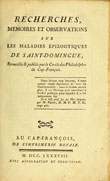Environment
A dazzling array of flora and fauna greeted Haiti's earliest visitors.
Travelers and local writers found Hispaniola a luxuriant paradise, not only endowed with tremendous economic potential, but also full of the wonderment of life, as defined by a rich variety of flora and fauna unknown in Europe. Great forests dominated the interior, which needed to be cleared for plantations (and whose wood contributed to boatbuilding). Nature carried grave danger (as Napoleon’s troops would discover when they encountered Haiti’s mosquitoes and the yellow fever they delivered). But it was also a source of unfettered admiration to the writers of works on the environment of this special place. An important scientific society, the Cercle des Philadelphes, conducted valuable research into the flora and fauna of the island, and was recognized by King Louis XVI. In addition to the native animals -- lizards, crocodiles, tortoises, exotic fish – there were many creatures brought by the Europeans, including horses, mules, cattle, and sheep, and some brought by Africans as well, including monkeys and African duck. Many plants that are now linked inextricably with the Caribbean (bananas, mangos, pineapples, citrus fruits, avocados) also originated with the Africans who came in large numbers. In 1742, Jean-Baptiste Labat wrote, “one does not know any other country in the world more abundant than this island, the land here has an admirable fecundity, rich, profound, and in a position of never ceasing to produce all that one could desire."


